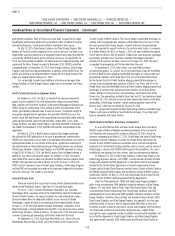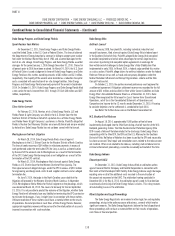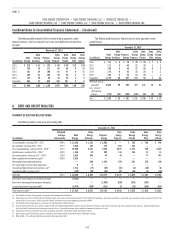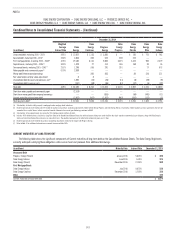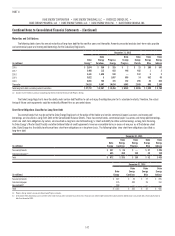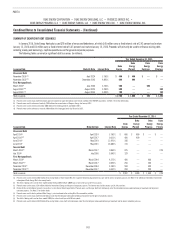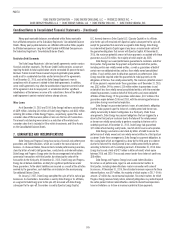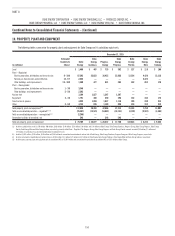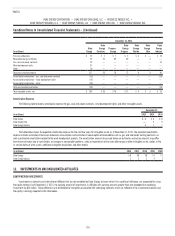Duke Energy 2015 Annual Report Download - page 165
Download and view the complete annual report
Please find page 165 of the 2015 Duke Energy annual report below. You can navigate through the pages in the report by either clicking on the pages listed below, or by using the keyword search tool below to find specific information within the annual report.
145
PART II
DUKE ENERGY CORPORATION • DUKE ENERGY CAROLINAS, LLC • PROGRESS ENERGY, INC. •
DUKE ENERGY PROGRESS, LLC • DUKE ENERGY FLORIDA, LLC • DUKE ENERGY OHIO, INC. • DUKE ENERGY INDIANA, INC.
Combined Notes to Consolidated Financial Statements – (Continued)
Money pool receivable balances are reflected within Notes receivable
from affiliated companies on the Subsidiary Registrants’ Consolidated Balance
Sheets. Money pool payable balances are reflected within either Notes payable
to affiliated companies or Long-Term Debt Payable to Affiliated Companies on
the Subsidiary Registrants’ Consolidated Balance Sheets.
Restrictive Debt Covenants
The Duke Energy Registrants’ debt and credit agreements contain various
financial and other covenants. The Master Credit Facility contains a covenant
requiring the debt-to-total capitalization ratio to not exceed 65 percent for each
borrower. Failure to meet those covenants beyond applicable grace periods
could result in accelerated due dates and/or termination of the agreements.
As of December 31, 2015, each of the Duke Energy Registrants were in
compliance with all covenants related to their debt agreements. In addition,
some credit agreements may allow for acceleration of payments or termination
of the agreements due to nonpayment, or acceleration of other significant
indebtedness of the borrower or some of its subsidiaries. None of the debt or
credit agreements contain material adverse change clauses.
Other Loans
As of December 31, 2015 and 2014, Duke Energy had loans outstanding
of $629 million, including $41 million at Duke Energy Progress and $603 million,
including $44 million at Duke Energy Progress, respectively, against the cash
surrender value of life insurance policies it owns on the lives of its executives.
The amounts outstanding were carried as a reduction of the related cash
surrender value that is included in Other within Investments and Other Assets
on the Consolidated Balance Sheets.
7. GUARANTEES AND INDEMNIFICATIONS
Duke Energy and Progress Energy have various financial and performance
guarantees and indemnifications, which are issued in the normal course of
business. As discussed below, these contracts include performance guarantees,
stand-by letters of credit, debt guarantees, surety bonds and indemnifications.
Duke Energy and Progress Energy enter into these arrangements to facilitate
commercial transactions with third parties by enhancing the value of the
transaction to the third party. At December 31, 2015, Duke Energy and Progress
Energy do not believe conditions are likely for significant performance under
these guarantees. To the extent liabilities are incurred as a result of the activities
covered by the guarantees, such liabilities are included on the accompanying
Consolidated Balance Sheets.
On January 2, 2007, Duke Energy completed the spin-off of its natural gas
businesses to shareholders. Guarantees issued by Duke Energy or its affiliates,
or assigned to Duke Energy prior to the spin-off, remained with Duke Energy
subsequent to the spin-off. Guarantees issued by Spectra Energy Capital,
LLC, formerly known as Duke Capital LLC, (Spectra Capital) or its affiliates
prior to the spin-off remained with Spectra Capital subsequent to the spin-off,
except for guarantees that were later assigned to Duke Energy. Duke Energy
has indemnified Spectra Capital against any losses incurred under certain of
the guarantee obligations that remain with Spectra Capital. At December 31,
2015, the maximum potential amount of future payments associated with these
guarantees was $205 million, the majority of which expires by 2028.
Duke Energy has issued performance guarantees to customers and other
third parties that guarantee the payment and performance of other parties,
including certain non-wholly owned entities, as well as guarantees of debt of
certain non-consolidated entities and less than wholly owned consolidated
entities. If such entities were to default on payments or performance, Duke
Energy would be required under the guarantees to make payments on the
obligations of the less than wholly owned entity. The maximum potential amount
of future payments required under these guarantees as of December 31, 2015,
was $253 million. Of this amount, $15 million relates to guarantees issued
on behalf of less than wholly owned consolidated entities, with the remainder
related to guarantees issued on behalf of third parties and unconsolidated
affiliates of Duke Energy. Of the guarantees noted above, $112 million of the
guarantees expire between 2016 and 2033, with the remaining performance
guarantees having no contractual expiration.
Duke Energy has guaranteed certain issuers of surety bonds, obligating
itself to make payment upon the failure of a wholly owned and former non-
wholly owned entity to honor its obligations to a third party. Under these
arrangements, Duke Energy has payment obligations that are triggered by a
draw by the third party or customer due to the failure of the wholly owned
or former non-wholly owned entity to perform according to the terms of its
underlying contract. At December 31, 2015, Duke Energy had guaranteed
$47 million of outstanding surety bonds, most of which have no set expiration.
Duke Energy uses bank-issued stand-by letters of credit to secure the
performance of wholly owned and non-wholly owned entities to a third party or
customer. Under these arrangements, Duke Energy has payment obligations to
the issuing bank which are triggered by a draw by the third party or customer
due to the failure of the wholly owned or non-wholly owned entity to perform
according to the terms of its underlying contract. At December 31, 2015, Duke
Energy had issued a total of $427 million in letters of credit, which expire
between 2016 and 2020. The unused amount under these letters of credit was
$58 million.
Duke Energy and Progress Energy have issued indemnifications
for certain asset performance, legal, tax and environmental matters to
third parties, including indemnifications made in connection with sales of
businesses. At December 31, 2015, the estimated maximum exposure for these
indemnifications was $97 million, the majority of which expires in 2017. Of this
amount, $7 million has no contractual expiration. For certain matters for which
Progress Energy receives timely notice, indemnity obligations may extend beyond
the notice period. Certain indemnifications related to discontinued operations
have no limitations as to time or maximum potential future payments.



